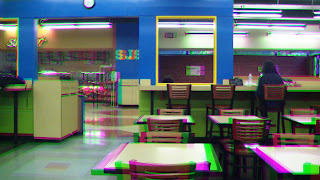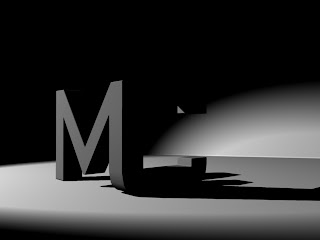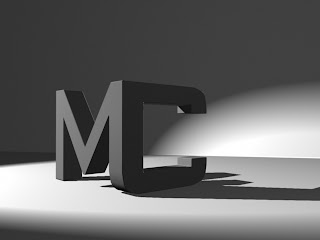Melvin Cunanan (Physics of Animation Blog)
Wednesday, December 5, 2012
Wednesday, November 28, 2012
Recreating Cameras and Lights in Maya
This is the original photograph. (IMG_5851.jpg)
This is the CG recreation as best as I could get it. The lights used in this recreation were mostly area lights, with the exception of a directional light used to create the main highlight on the left of the widget.
There were some things on the recreation that I was not able to accomplish. On the photograph the light was bouncing off the ground, making upward shadows on the steps. To do this I had to create a small area light just on the bottom corner of the steps. I was able to create the upward shadows on the two steps but I could not make the shadow on the bottom because there was nothing to cast a shadow from. The reason why those shadows are so grainy is because Mental Ray is active on that light. That was the best way that I could get some kind of gradient look on those shadows, like how it was on the photograph.
Also, I could not apply the penumbra effect on the shadow from the main light source. I originally tried to use a spotlight which has the penumbra angle attribute but the spotlight did not give me the direction of light that I wanted. Mental Ray was not a good choice either because it produced a very contrast gradient on the shadow.
This is the recreation on a different angle. There was originally an area light on the right of the widget to produce a small highlight on the other view, but on this view it was removed because the area light was producing too much light where the shadow should be.
Tuesday, November 20, 2012
Monday, November 12, 2012
Monday, November 5, 2012
Outline for the Second Term Paper
I.
Introduction
a.
Thesis: These scenes from the Marvel films show
that some of the motions from the characters presented violations of the
action/reaction principle.
II.
Thor
a.
The Bifrost machine teleports Thor and his
friends at extreme speeds and while still going at an extreme speed they are
able to land safely to their destination on another planet.
b.
In the fight with the Frost Giants, Thor is able
to fling the giants (eight to nine foot high creatures and three times the
weight of Thor) several feet into the air with his Mjolnir hammer effortlessly.
c.
Near the ending when he shows Jane Foster his
powers, Thor is able to jump hundreds of feet into the air and miles away
without making a single leap with his legs.
III.
Captain America: The First Avenger
a.
In the scene where Steve Rogers is chasing the
Hydra spy, he makes a giant leap to go above a fence that is around 9 feet
high.
b.
Near the end of the film, Captain America is
fighting one of the Hydra soldiers and both are on top of a small fighter
plane. When the plane is ejected down, both Captain America and the Hydra
soldier are not experiencing any weightlessness.
c.
At the post-credits scene, Captain America is
able to break a punching bag that is almost more than his weight.
IV.
The Avengers
a.
At the fight with Thor vs. Iron Man and Captain
America, Thor wields his Mjolnir hammer towards Captain America’s shield and
after impact it causes a shockwave that forces everyone to slide off several
feet away from the impact.
b.
When SHIELD’s air carrier is under attack, the
Hulk jumps off from the carrier’s lab to a fighter jet almost 50 feet across
with making only minimal damage on both ends but not from the forces of the jump.
c.
At the battle with the Chitari, The Hulk is able
to stop (with one single punch) the massive creature that is more than 100
times the Hulk’s size and weight.
V.
Conclusion
Tuesday, October 30, 2012
Stop-Motion Character Animation
Click the icon on the bottom right of the video for a full-screen view.
The first thing I did was make the character. He is made with a bendable skeleton made with sturdy metal wires and wrapped with aluminum foil. Afterwards the model was covered with clay. I made the model this way because I had uncertainty if the I might lose shape of the character or accidently breaking the limbs if the model was entirely clay. On a standing pose the character was able to stay up well. But on poses where the character was standing in one foot, a small piece of clay had to be underneath the other foot to support the character. The small piece is edited out by Photoshop after shooting.
After building the model character, I shot reference of myself acting out the scene. For shooting the poses, I was able to twist the body (not efficient but just good enough), keep the body sturdy and standing by itself (most of the time). On the last scene where the character melts, the model is replaced with a different model with all clay so I can easily smash it.
This assignment was slightly difficult because after shooting each frame it is hard to tell how far the body needs to curve or how far the foot needs to travel between each frame. I also had to fix the character if the character bended too much and the clay cracked: which meant I had to take the character off the stage, put tracking markers on the stage and putting the character back hoping it did not shift too much from the previous frame.
Subscribe to:
Comments (Atom)










